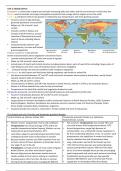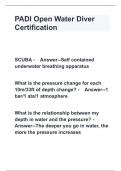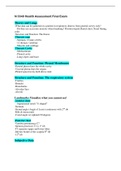Unit
2:
Global
biomes
Ecosystem-‐
a
community
of
plants
and
animals
interacting
with
each
other
and
the
environment
in
which
they
live
Biome-‐
used
to
describe
very
large-‐scale
global
ecosystems
that
occupy
distinct
regions
across
the
earth
Tundra-‐
a
cold
biome
where
tree
growth
is
hindered
by
low
temperatures
and
short
growing
seasons
• Found
in
extreme
high
latitudes,
generally
polewards
of
around
600
• Makes
up
11%
of
earth’s
land
surface
• Includes
northern
Alaska,
and
Canada
in
North
America,
around
coastline
of
Greenland
and
north
coast
of
Russia
including
Siberia,
Iceland
• Characterised
by
extreme
cold
temperatures,
no
trees
and
limited
ground
vegetation
Tropical
rainforest-‐
a
hot
and
wet
biome
characterised
by
dense
vegetation
and
diverse
fauna
• Located
mainly
between
100
north
and
south
of
equator
• Make
up
13%
of
earth’s
land
surface
• Include
parts
of
South
and
Central
America
including
amazon
basin,
parts
of
west
Africa
including
Congo,
parts
of
Indo-‐Malaysia
and
north
coast
of
Australia,
Brazil,
Cameroon,
Singapore
•
Characterised
by
hot
and
wet
conditions
with
evergreen
vegetation
Hot
deserts-‐
an
arid,
barren
and
hot
biome
lacking
vegetation
and
hostile
to
animal
life
• Hot
deserts
located
between
150
and
300
north
and
south
of
equator
where
easterly
winds
blow,
mostly
found
towards
western
sides
of
continents
• Make
up
19%
od
earth’s
surface
• Include
deserts
of
Mexico
and
SW
USA,
Atacama
in
South
America,
Namib
in
S
Africa,
the
Australian
desert,
Sahara
in
N
Africa
extends
from
west
to
east
of
continent
• Temperatures
hot
with
little
rainfall
and
vegetation
limited
to
scrub
Temperate
grasslands-‐
terrestrial
biomes
dominated
by
grasses
and
underlain
by
fertile
soils
• Found
in
mid-‐latitudes
between
300
and
400
N
and
S
of
equator
• Make
up
13%
of
earth’s
land
surface
• Largest
bands
in
northern
hemisphere
within
continental
interiors
of
North
America
(Prairies,
USA),
Southern
Russia
(Steppes).
Southern
hemisphere
less
extensive
sound
on
eastern
coast
of
S
America
(Pampas),
South
Africa
(Veld),
Australian
Bush,
Kazakhstan,
Argentina
• Characterised
by
hot
summers,
cold
winters,
limited
rainfall
and
short
to
tall
grasses
The
climate
and
soils
of
tundra
and
temperate
grassland
biomes
Tundra
climate
e.g.
Barrow,
Alaska,
USA
Temperate
grassland
climate
e.g.
Saskatoon,
Saskatchewan,
Canada
• Winters
severe-‐
long
periods
of
very
cold
conditions
• Hot
summers-‐
temperatures
may
exceed
300C
and
• Temperatures
low
annual
average
of
00C
with
6-‐10
very
cold
winters
with
temperatures
below
-‐300C
months
temperatures
below
freezing.
Winters
can
see
• Annual
temperature
range
high
because
of
temperatures
permanently
below
-‐250C
continentality-‐
as
a
continental
interior,
Saskatoon
is
• Land
often
subject
to
permafrost
(permanently
frozen
far
from
moderating
influence
of
sea.
In
summer,
land
underground)
with
some
surface
thaw
in
summer
temperatures
rise
rapidly
but
in
winter
land
looses
• Because
tundra
receives
very
little
insolation
from
sun
heat
by
radiation
loss
and
temperatures
drop
as
there
can
be
20
hours
darkness
in
December
due
to
• Long,
cold
winters
and
hard
frost
breaks
up
soils
low
angle
of
sun
in
the
sky
•
105-‐135
frost-‐free
days
per
year
extend
growing
• Precipitation
normally
in
form
of
snow,
totals
irregular
season
(spring
wheat
requires
100
frost
free
days)
below
250mm,
less
than
some
desert
regions
• Up
to
16
summer
daylight
hours
per
day
encouraging
• Because
high
pressure
dominates
tundra
areas
so
rapid
crop
growth
and
assists
early
autumn
harvesting
clouds
unlikely
to
form
due
to
sinking
air
conditions
• Precipitation
levels
generally
very
low
typically
• Growing
season
short
less
than
50
days
in
summer
between
400-‐500mm/
year
in
N
American
Prairies
• Strong
winds
throughout
year
averaging
45-‐90km/h
• Largely
due
to
rainshadow
effect
from
Rocky
, •
Although
plenty
of
water
in
environment
much
is
Mountains
unavailable
to
plants
as
it
is
frozen
or
temperatures
• Rainfall
totals
can
be
higher
in
spring/
summer
due
to
too
cold
for
uptake
by
roots-‐
physiological
drought
convectional
activity
but
warm
temperatures
lead
to
• When
some
thawing
happens
in
summer,
water
higher
levels
of
evapotranspiration-‐
further
reducing
cannot
percolate
deeper
due
to
underlying
water
availability
in
the
soil
permafrost.
Summer
landscapes
dominated
by
lakes
• Thunderstorms
common
in
summer
with
hail-‐
this
can
and
marshes.
lead
to
high
levels
of
runoff
into
rivers
• Plant
life
dominated
by
rushes,
sedges,
dwarf-‐willow
• Lack
of
rainfall
and
limited
water
supply
in
long
7
and
grasses
that
spread
sideways
across
landscape
to
month
winter
season,
prevents
establishment
of
capture
as
much
sunlight
as
possible.
They
flower
and
forests
but
allowing
tall
seasonal
grasses
to
dominate
reproduce
quickly
in
short
summer
season
as
they
tolerate
drier
conditions.
Trees
only
survive
along
rivers
and
streams
Soils-‐
solid
material
that
forms
on
the
earth’s
surface
as
a
result
of
weathering
of
the
rock
surface
and
addition
of
organic
material
from
biological
activity
Ø Soil
is
25%
air,
25%
water,
45%
mineral
particles,
5%
organic
matter
(10%
organisms,
10%
roots,
80%
humus)
Ø Soils
represented
in
vertical
section
called
soil
profile,
which
is
divided
into
layers
known
as
soil
horizons
Ground
surface-‐
vegetation
A
horizon-‐
topsoil
containing
decomposed
organic
material
known
as
humus,
a
rich
source
of
plant
nutrients
B
horizon-‐
sub
soil
mostly
composed
of
inorganic
rock
fragments
C
horizon-‐
parent
material-‐
the
rock
on
which
and
from
which
the
soil
is
formed
Ø Process
that
shape
soil
formation:
weathering,
decomposition,
leaching,
capillary
action
Ø Soil
structure
types:
granular,
crumb,
blocky,
sub-‐angular
blocky,
prismatic,
columnar,
platy,
single
grain/
structureless
(how
soil
grains
group/
clump
together)
Soil
forming
factors
1. Parent
material-‐
can
influence
texture
and
fertility
of
soil
due
to
its
chemistry
2. Climate-‐
can
influence
soils
nature
as
can
control
weathering
and
organic
activity
3. Organisms-‐
can
determine
soil
chemistry,
pH
value
and
nutrient
status
4. Relief-‐
topographical
shape
of
land
changes
soil
processes
5. Time-‐
length
of
time
soil
has
had
to
develop
will
change
its
nature
Soils-‐
Temperate
grasslands
Temperate
grassland
soils
called
mollisols
or
chernozems-‐
they
are
humus
and
mineral
rich,
black,
crumbly
soils
and
cover
7%
of
earth’s
land
surface
e.g.
Saskatoon,
Saskatchewan,
Canada
Characteristic
Description
Explanation
Colour
Very
dark,
even
black
through
much
Tall
grasses
that
die
in
autumn
including
their
many
roots
of
depth
(reflects
chemical
provide
large
influx
of
organic
matter.
This
darkens
soil
which
is
composition
of
soil)
main
nutrient
store
in
this
ecosystem
Depth
Most
1-‐2m
deep
(compared
to
most
Mollisols
young
soils
forming
after
ice-‐age
but
weathering
of
garden
soils
being
50cm)
parent
material
fairly
rapid,
increasing
depth
from
below.
Much
organic
matter
also
added
from
above
increasing
depth
Texture
Most
have
clay/loam
mix.
(clay
has
Partly
controlled
by
underlying
parent
material
but
also
wind-‐
small
grain
sizes
and
loams
have
mix
blown
fine
sands
termed
loess,
which
mix
with
soil
of
large,
medium
and
small
grains)
Acidity
Generally
slightly
acidic,
neutral
or
Relatively
high
pH
values
maintained
by
abundant
supply
of
slightly
alkaline
(pH
6-‐7.5)
down
organic
nutrients
(calcium
carbonate)
from
parent
material,
the
through
their
profiles
recycling
of
tall
grasses
and
lack
of
significant
leaching
Structure
Crumb
structure-‐
when
rubbed
soils
Sands,
silts
and
clays
combine
with
humus
and
organic
acids.
form
loose
circular
clumps
with
open
Lack
of
leaching
allows
nutrients
and
organic
‘glues’
to
stay
in
pore
spaces
soil










